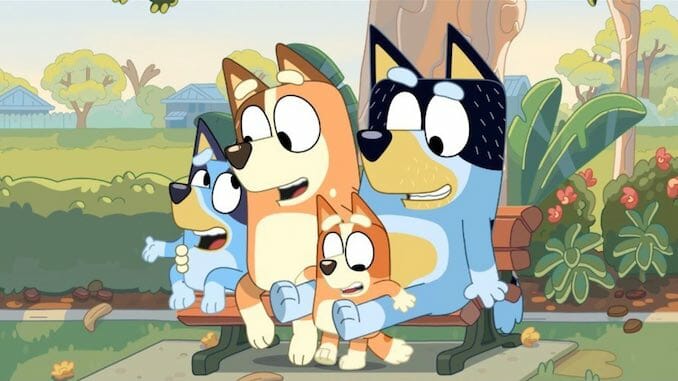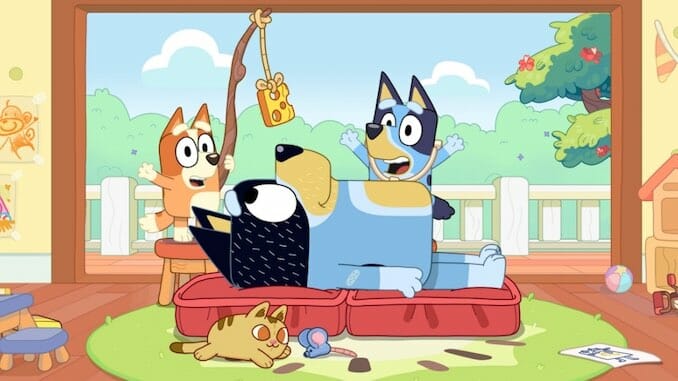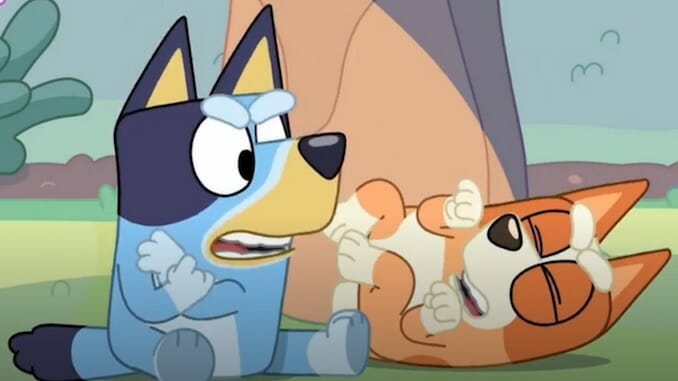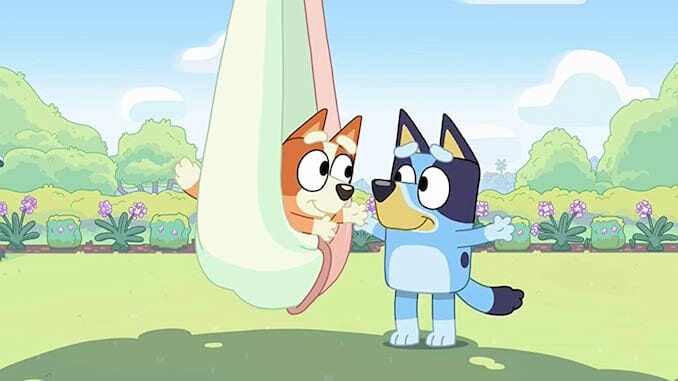Comfort Watch of the Month: Bluey on Disney+
Photo Courtesy of Disney+
Comfort Watch of the Month is a new column dedicated to the happiest television shows available on streaming. Each month, I will give a full rundown on why a different series should be your go-to comfort watch, breaking them down into three categories: Family + Friends, Conflict, and Love. At the end, these shows will be given a score — not a numerical value, but a comfortable feeling or situation that they evoke.
The creators of these shows infuse love and care into their projects. They feature characters we can relate to, or we aspire to be. They give us hope in humanity, belief that everything will turn out okay if we’re all just a tad bit kinder. They’re still well-made, but unabashedly sweet, never afraid to make you cry; but happy tears only. They put a big, cheesy smile on my face. Maybe they can do the same for you.
![]()
Bluey has become a phenomenon. The Australian TV series debuted in 2018 with a 52-episode season comprising 7-minute moments in the life of a loving family living in Queensland. With three seasons and over 150 episodes under its belt, Bluey knows what it is and what it represents: a program designed for both children and parents. It’s for everyone who’s willing to learn something new, or be reminded of just how fun it is to be young.
In each of its short episodes, Bluey—a six-year-old Blue Heeler puppy—along with her younger sister, Bingo, play with each other, their parents (Bandit and Chili), and their friends. That’s it. There’s nothing else to creator Joe Blumm’s Bluey, and there doesn’t need to be. It’s a series filled with the simplest of loves, the purest of imaginations, the most child-like wonder. Bluey and Bingo pretend to be pirates, shopkeepers, taxi drivers, cleaners, hotel management, and every other job under the sun, alongside the ever-increasing patience of their parents. The two children and their large group of friends (this family seems to be, deservedly, quite well-liked in the community) absorb life around them, tackling their sadness, jealousy, fear, and lack of confidence in 7-minute spurts.
Every episode transforms into a small reminder of how light life can be, of how much joy can come from being silly around the people you love. For kids, the show is a learning tool. For parents, it can be used as a distraction. For adults who spend several hours per day staring at a laptop for more stressful reasons, like me, Bluey is gentle respite, unfettered happiness depicted on screen.
Family + Friends

Bluey’s all about family and friends. It’s about the enjoyment of playing games with the ones you love. With each passing 7-minute stretch, the Heelers become more enjoyable to watch, and more integrated into your own life. They care for one another, they hug and cuddle as much as they can, but they aren’t perfect. The dad snaps when he’s trying to work, the mom isn’t always appreciated, and the kids hurt one another without even realizing it. The show doesn’t want its titular family, or character, to be flawless; the writers just want to emphasize love and care over everything else.
Both parents work, play, cook, and support their children as best they can. Inspired by Brumm’s own experience raising his two daughters, the series seems to be run as a family operation. Brumm’s own mom voices the grandmother, his brother voices the Uncle, and the kids of the production team ended up becoming voice actors for the children in the series.
Bluey and Bingo’s friends represent a fuller range of dog breeds, with Dalmatians, Labradors, Afghan Hounds, Beagles, and Border Collies acting as often and willing participants. Because there isn’t much of a linear narrative, new characters (friends) can pop up without an obligatory backstory or introduction. These short films can feature different casts without missing a beat, and as noted in much of Bluey and real life, kids simply want to play.
Conflict

Parents rarely yell in Bluey. Fights don’t break out. Arguments never last longer than a couple of minutes. Conflict exists in a vacuum in the Australian television series, as people don’t go to bed angry and the days always end in laughter, rather than tears. The idea of conflict almost doesn’t register for Bluey and Bingo, and the rest of their classmates. They want to resolve any tension as it bubbles up, so that they can continue living without responsibilities or burden.
The only problems are the ones that come up while playing—little issues that require simple solutions. Be more patient with each other. Allow another kid to pick what the shop is going to sell. Include everyone in your games, rather than being exclusive. And when a real matter comes up, like Bingo having to spend multiple days in the hospital, do everything in your power to bring positivity into others’ lives. In that case, Bluey and her dad make a home movie telling a story about purple underpants. I’d like to think I’m not the only adult who cried seven minutes later.
The show has made ripples, and hopefully will soon make waves, in its depiction of differences between children and between families. In sporadic episodes throughout the first two seasons, both of which are available on Disney+ (along with the already-aired first half of the third season), the animated series explores attention deficit issues, deafness, fertility, and bullying, often through the eyes of a child, simplifying complex topics. It might act as educational for those under the age of 10, but this thoughtfulness serves as a reminder to adults on how to handle conflict, how to embrace dissimilarity, and how to accept others without judgment.
Love

The love in Bluey comes from Brumm’s own love of his daughters. The show focuses most though on sisterly love, a sibling relationship that ebbs and flows depending on the day. Their love is built on a shared imagination, an excitement and wonder towards experiencing the world. Though Bluey is two years older than her younger sister, usually, they’re both seeing, learning, and feeling the vastness of the world at the same time.
And then there’s the love Bandit and Chili have for their children—endless support that displays itself through endless amounts of energy. They play with their kids constantly, validating their ideas, their imaginations, and their feelings. The parents seem to apply improv rules to their parenting style: always say “Yes, and…” when the children come up with a new scenario. It might not be a sustainable method, but it provides genuine glee.
Love equates to an authentic passion to spend time with one another, an undisputed decision to play with one’s sibling, one’s children, one’s friends. Wild imaginations aren’t just accepted, but encouraged by this family of Heelers. And who am I to say that love should be described any differently? Bluey has taught millions of children and adults, including myself, about love, growing up, and parenting in the most digestible episodes currently on television. I love Bluey, and if you give these adorable dogs a few minutes of your day, I’m sure you will, too.
Comfort Score: Like playing sharks and minnows at recess with all of your best friends in third grade.
Two seasons of Bluey are available to stream on Disney+. The first half of the third season will premiere on August 10, 2022 on the service.
Brooklyn-based film and TV journalist Michael Frank contributes to several outlets including The Film Stage, RogerEbert, AwardsWatch, and now Paste. He believes Juliette Binoche deserved an Oscar for Dan in Real Life. You can find him on Twitter.
For all the latest TV news, reviews, lists and features, follow @Paste_TV.







































